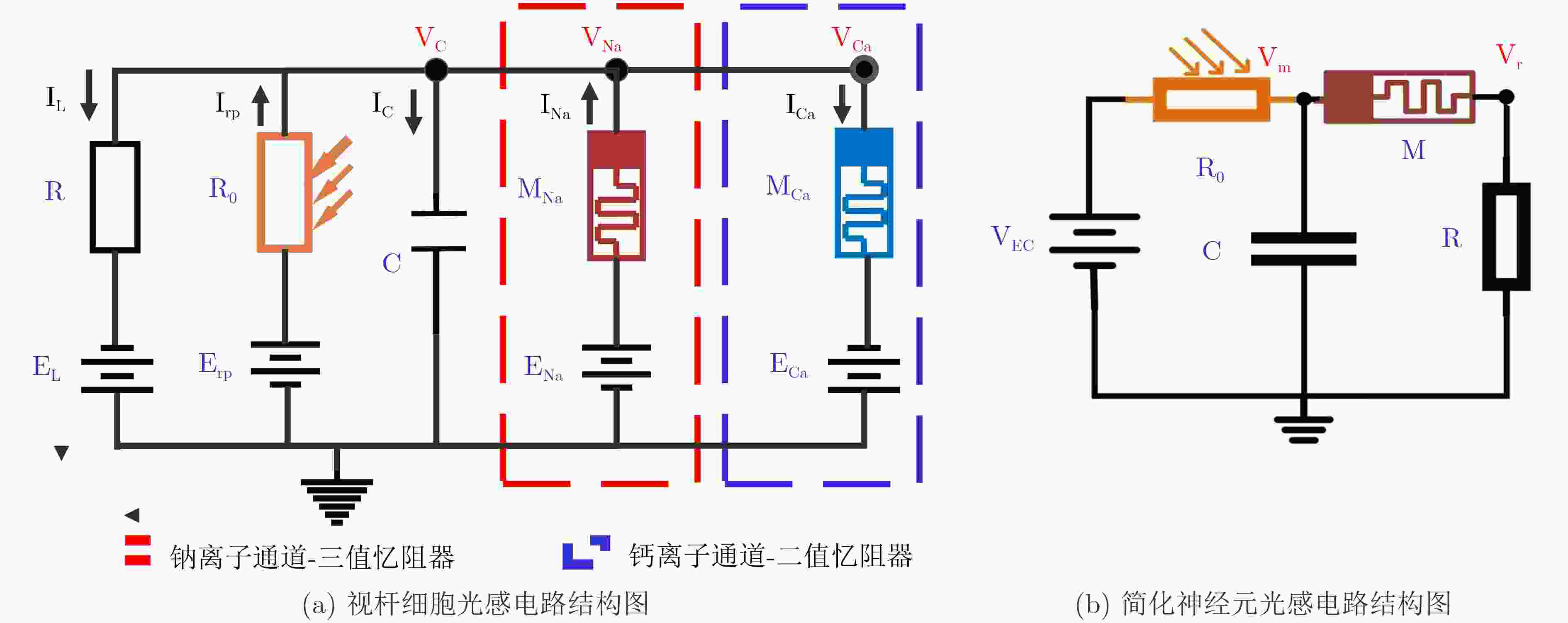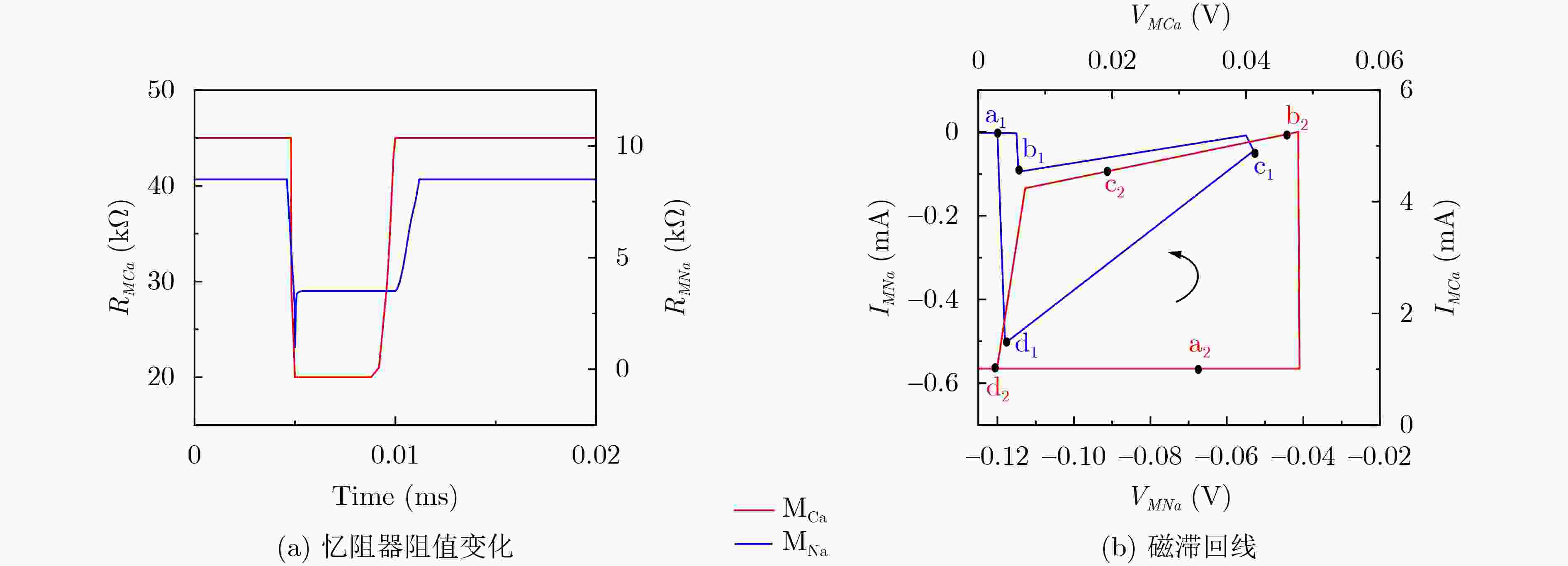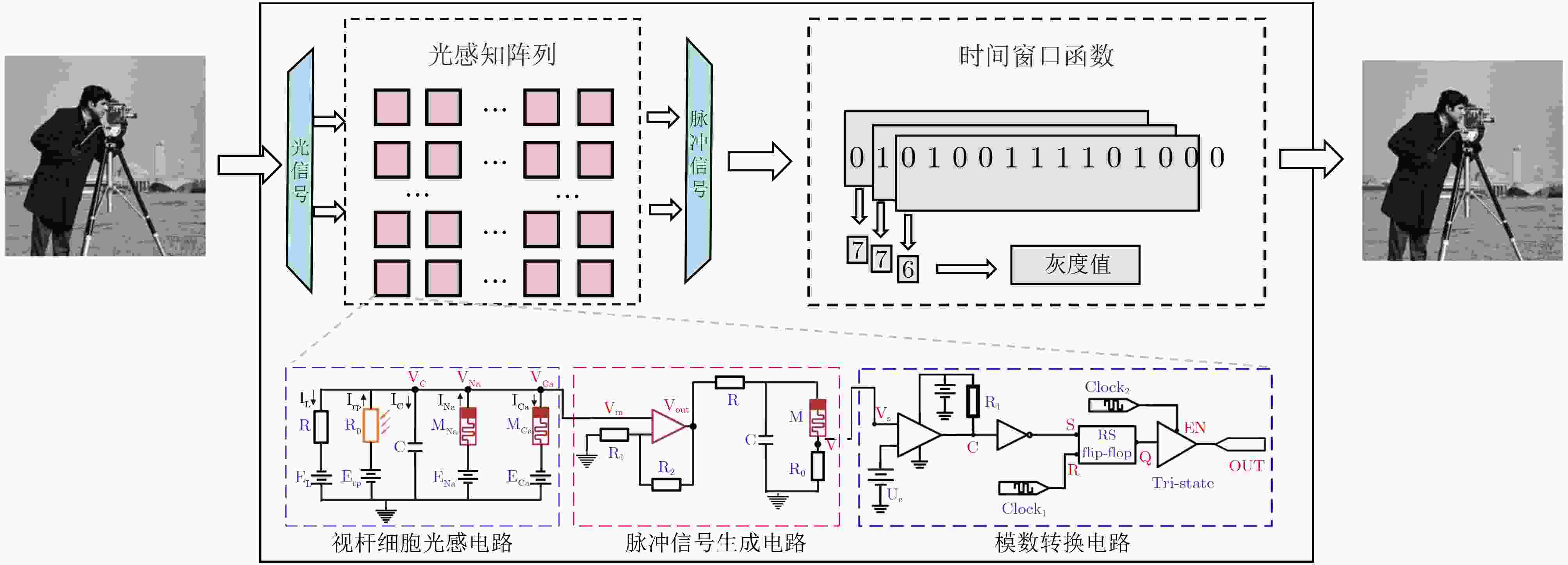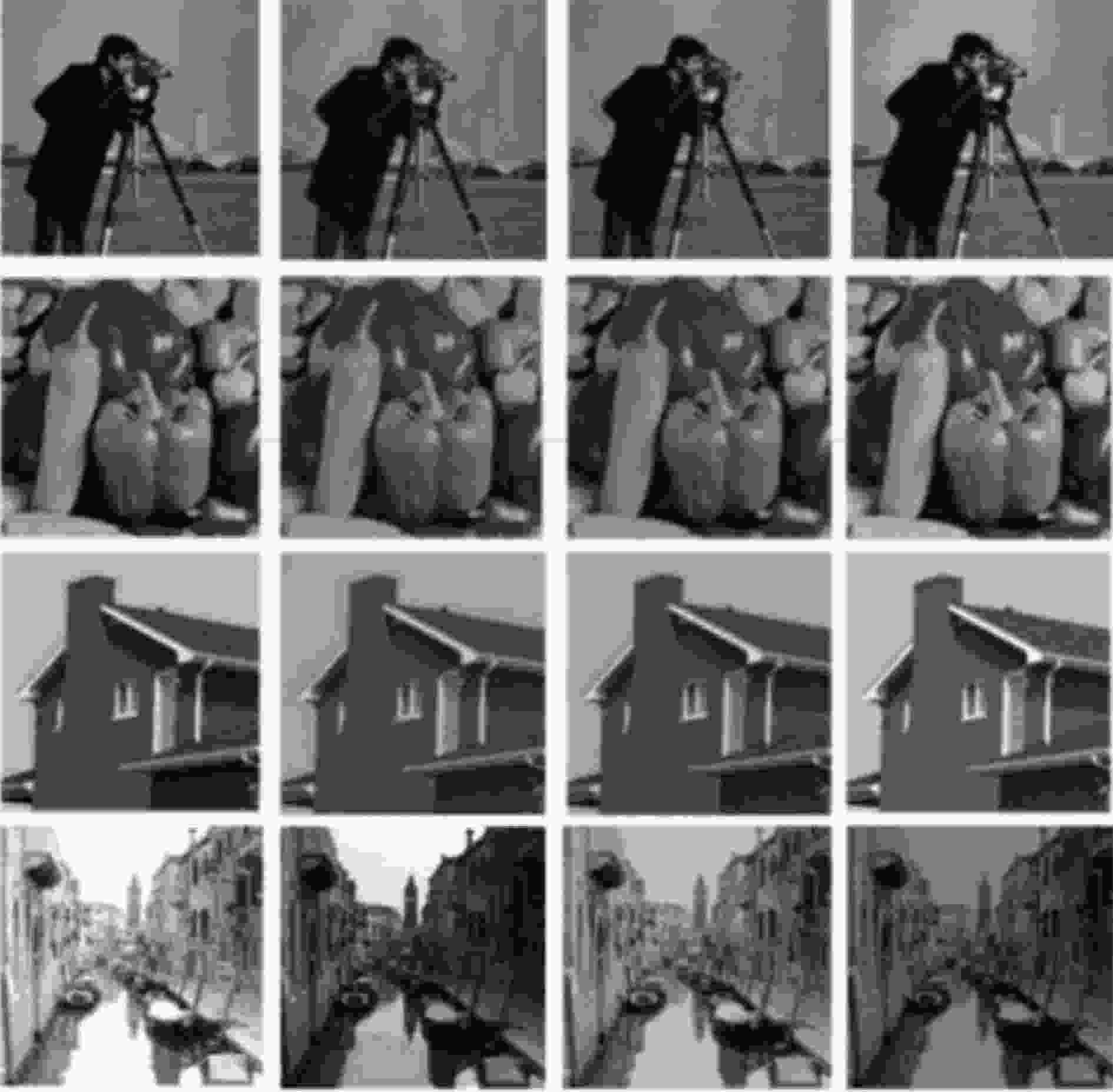-
摘要: 人类视觉系统通过多层神经元相互配合,实现了具备自适应性、灵敏度高、响应速度快的光感知功能。本文通过研究人类视觉系统中感光细胞的工作原理,提出了一种基于忆阻器的视杆细胞光感电路,并应用于脉冲相机。首先,通过总结视杆细胞感光过程中离子变化机制提出了视杆细胞数学模型。其次,提出两种忆阻器模型以模拟感光细胞中钠离子和钙离子通道的特性。之后,构建了视杆细胞光感电路,实现光电转换,电路具备自适应性,同时具有速度高、功耗低、动态范围广等优势。最后将视杆细胞光感电路应用于脉冲相机,电路仿真结果表明,与采用简化神经元光感电路和传统CMOS方案的脉冲相机相比,基于视杆细胞光感电路的脉冲相机转换速度提升了20%和150%,系统功耗相比于传统CMOS电路降低了30%。
-
表 1 离子忆阻器参数设置
离子通道 $ {R}_{off} $ $ {R}_{on} $ $ {V}_{th} $ $ {V}_{h} $ $ {b}_{1} $ $ {b}_{2} $ $ {q}_{1} $ $ {q}_{2} $ Na+ 1MΩ - –110 mV –119.5 mV 15 2 - - Ca2+ 1 MΩ 30 kΩ 50 mV 7 mV 18 –9.8 –0.51 –0.51 -
[1] HE Bin, MIAO Qihang, ZHOU Yanmin, et al. Review of bioinspired vision-tactile fusion perception (VTFP): From humans to humanoids[J]. IEEE Transactions on Medical Robotics and Bionics, 2022, 4(4): 875–888. doi: 10.1109/TMRB.2022.3215749. [2] 宋爱国, 田磊, 倪得晶, 等. 多模态力触觉交互技术及应用[J]. 中国科学: 信息科学, 2017, 47(9): 1183–1197. doi: 10.1360/N112017-00081.SONG Aiguo, TIAN Lei, NI Dejing, et al. Multi-mode haptic interaction technique and its application[J]. Scientia Sinica Informationis, 2017, 47(9): 1183–1197. doi: 10.1360/N112017-00081. [3] 王若萱, 吴建平, 徐辉. 自动驾驶汽车感知系统仿真的研究及应用综述[J]. 系统仿真学报, 2022, 34(12): 2507–2521. doi: 10.16182/j.issn1004731x.joss.22-FZ0921.WANG Ruoxuan, WU Jianping, and XU Hui. Overview of research and application on autonomous vehicle oriented perception system simulation[J]. Journal of System Simulation, 2022, 34(12): 2507–2521. doi: 10.16182/j.issn1004731x.joss.22-FZ0921. [4] HUANG Yongjun, MA Liang, HUANG Zihan, et al. High-precision temperature sensor system with mercury-based electromagnetic resonant unit[J]. IEEE Internet of Things Journal, 2024, 11(8): 14671–14681. doi: 10.1109/JIOT.2023.3343568. [5] 付强, 陈向阳, 郑子亮, 等. 仿生扑翼飞行器的视觉感知系统研究进展[J]. 工程科学学报, 2019, 41(12): 1512–1519. doi: 10.13374/j.issn2095-9389.2019.03.08.001.FU Qiang, CHEN Xiangyang, ZHENG Ziliang, et al. Research progress on visual perception system of bionic flapping-wing aerial vehicles[J]. Chinese Journal of Engineering, 2019, 41(12): 1512–1519. doi: 10.13374/j.issn2095-9389.2019.03.08.001. [6] KABILAN R and MUTHUKUMARAN N. A neuromorphic model for image recognition using SNN[C]. 2021 6th International Conference on Inventive Computation Technologies (ICICT), Coimbatore, India, 2021: 720–725. doi: 10.1109/ICICT50816.2021.9358663. [7] WANG Dashuai, LI Wei, LIU Xiaoguang, et al. UAV environmental perception and autonomous obstacle avoidance: A deep learning and depth camera combined solution[J]. Computers and Electronics in Agriculture, 2020, 175: 105523. doi: 10.1016/j.compag.2020.105523. [8] LIAO Fuyou, ZHOU Feichi, and CHAI Yang. Neuromorphic vision sensors: Principle, progress and perspectives[J]. Journal of Semiconductors, 2021, 42(1): 013105. doi: 10.1088/1674-4926/42/1/013105. [9] THEUWISSEN A J P. Solid-State Imaging with Charge-Coupled Devices[M]. Dordrecht: Springer, 1995. doi: 10.1007/0-306-47119-1. . [10] BIGAS M, CABRUJA E, FOREST J, et al. Review of CMOS image sensors[J]. Microelectronics Journal, 2006, 37(5): 433–451. doi: 10.1016/j.mejo.2005.07.002. [11] 吴南健. 半导体智能视觉系统芯片[J]. 中兴通讯技术, 2020, 26(2): 38–42. doi: 10.12142/ZTETJ.202002006.WU Nanjian. Semiconductor smart vision system chips[J]. ZTE Technology Journal, 2020, 26(2): 38–42. doi: 10.12142/ZTETJ.202002006. [12] SCHNAPF J L and BAYLOR D A. How photoreceptor cells respond to light[J]. Scientific American, 1987, 256(4): 40–47. doi: 10.1038/scientificamerican0487-40. [13] YOUNG R W. The renewal of photoreceptor cell outer segments[J]. Journal of Cell Biology, 1967, 33(1): 61–72. doi: 10.1083/jcb.33.1.61. [14] MEAD C A and MAHOWALD M A. A silicon model of early visual processing[J]. Neural Networks, 1988, 1(1): 91–97. doi: 10.1016/0893-6080(88)90024-X. [15] MEAD C and ISMAIL M. Analog VLSI Implementation of Neural Systems[M]. New York: Springer, 1989. doi: 10.1007/978-1-4613-1639-8. . [16] YANG Chuan, SUN Bai, ZHOU Guangdong, et al. Photoelectric memristor-based machine vision for artificial intelligence applications[J]. ACS Materials Letters, 2023, 5(2): 504–526. doi: 10.1021/acsmaterialslett.2c00911. [17] BRUNEL N and VAN ROSSUM M C W. Lapicque's 1907 paper: From frogs to integrate-and-fire[J]. Biological Cybernetics, 2007, 97(5/6): 337–339. doi: 10.1007/s00422-007-0190-0. [18] ZHU Shirui, XIE Tao, LV Ziyu, et al. Hierarchies in visual pathway: Functions and inspired artificial vision[J]. Advanced Materials, 2024, 36(6): 2301986. doi: 10.1002/adma.202301986. [19] HODGKIN A L and HUXLEY A F. A quantitative description of membrane current and its application to conduction and excitation in nerve[J]. The Journal of Physiology, 1952, 117(4): 500–544. doi: 10.1113/jphysiol.1952.sp004764. [20] HUBBARD R and KROPF A. The action of light on rhodopsin[J]. Proceedings of the National Academy of Sciences of the United States of America, 1958, 44(2): 130–139. doi: 10.1073/pnas.44.2.130. [21] PALCZEWSKI K. G protein–coupled receptor rhodopsin[J]. Annual Review of Biochemistry, 2006, 75(1): 743–767. doi: 10.1146/annurev.biochem.75.103004.142743. [22] CARNEVALE N T and HINES M L. The NEURON Book[M]. Cambridge: Cambridge University Press, 2006. doi: 10.1017/CBO9780511541612. . [23] 黄培元, 宋禹桐, 张宁, 等. 基于光控蛋白质相互作用的光遗传学技术及其应用[J]. 中国激光, 2020, 47(2): 0207010. doi: 10.3788/CJL202047.0207010.HUANG Peiyuan, SONG Yutong, ZHANG Ning, et al. Optogenetics based on light-gated protein-protein interactions and its applications[J]. Chinese Journal of Lasers, 2020, 47(2): 0207010. doi: 10.3788/CJL202047.0207010. [24] HUANG Tiejun, ZHENG Yajing, YU Zhaofei, et al. 1000× faster camera and machine vision with ordinary devices[J]. Engineering, 2023, 25: 110–119. doi: 10.1016/j.eng.2022.01.012. -






 下载:
下载:












 下载:
下载:
